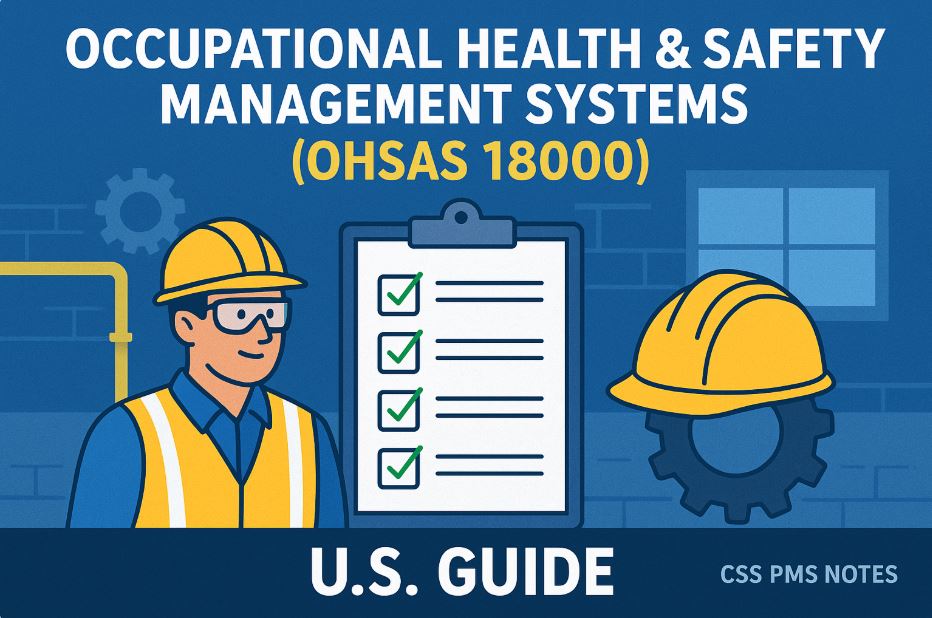Occupational Health & Safety Management Systems (OHSAS 18000): Protecting Workers, Boosting Business

Introduction – Why Safety Is Good Business
Every day, millions of workers face risks at work — from factory floors to office spaces.
A single accident can change lives, damage reputation, and cost thousands of dollars. That’s where Occupational Health & Safety Management Systems (OHSMS) come in. They help companies reduce hazards, follow safety laws, and build trust.
Let’s understand how OHSAS 18000, one of the earliest global safety standards, shaped workplace safety — and how U.S. businesses can use these systems today to protect workers and grow stronger.
What Is an Occupational Health & Safety Management System (OHSMS)?
An OHSMS is a structured system that helps organizations manage health and safety risks at work.
It sets clear procedures to identify hazards, control risks, and monitor performance.
Definition
“An Occupational Health and Safety Management System (OHSMS) provides a framework to manage safety risks, prevent injuries, and ensure legal compliance in the workplace.”
This system ensures everyone — from workers to managers — knows their role in keeping the workplace safe.
Understanding OHSAS 18000
OHSAS 18000 is a series of international standards for occupational health and safety management.
It includes OHSAS 18001, which defines the requirements for implementing a safety management system.
- Developed in 1999, it was a response to the growing need for global safety consistency.
- It ensures organizations create a safe working environment and reduce workplace accidents.
- It focuses on hazard identification, risk assessment, and prevention.
Although ISO 45001 has replaced OHSAS 18001, many companies still follow its principles as part of their continuous improvement process.
OHSAS 18001 vs ISO 45001
| Feature | OHSAS 18001 | ISO 45001 |
|---|---|---|
| Type | British Standard | International ISO Standard |
| Focus | Risk control | Risk management & leadership |
| Structure | Based on ISO 9001:2008 | Based on Annex SL (modern ISO format) |
| Employee Role | Limited involvement | Strong employee participation |
| Integration | Harder to integrate | Easier integration with ISO 9001 & 14001 |
Key takeaway:
U.S. businesses can still use OHSAS principles to strengthen their safety programs while transitioning to ISO 45001.
Core Principles of an OHSMS
An effective Occupational Health & Safety Management System includes four major components:
- Policy – A written commitment to safety.
- Planning – Identifying risks and setting safety goals.
- Implementation & Operation – Training employees, following procedures, and using safety equipment.
- Checking & Review – Monitoring progress and improving continuously.
Example (Daily Life)
Just like a driver checks brakes, mirrors, and fuel before a trip, a company using OHSMS checks safety measures before work begins.
Benefits of Implementing an OHSMS in the U.S.
Implementing an OHSMS isn’t just about compliance — it’s about smart business.
Key Benefits
- Fewer workplace accidents and injuries.
- Compliance with OSHA (Occupational Safety and Health Administration) standards.
- Lower insurance and compensation costs.
- Improved employee morale and productivity.
- Stronger reputation and trust among clients and partners.
- Better chance at winning international contracts that require safety certification.
Real Example
A construction company in Texas reduced its incident rate by 45% within a year after adopting OHSAS 18001 practices — saving money and lives.
How to Implement an OHSMS (Step-by-Step Guide)
| Step | Action | Goal |
|---|---|---|
| 1 | Develop a health & safety policy | Show leadership commitment |
| 2 | Identify workplace hazards | Understand where risks exist |
| 3 | Conduct risk assessments | Measure and prioritize risks |
| 4 | Establish control measures | Prevent or reduce accidents |
| 5 | Train and involve employees | Promote safety awareness |
| 6 | Monitor and review | Improve continuously |
| 7 | Seek certification | Demonstrate credibility |
💡 Tip: Small businesses can start simple — focus on training, hazard control, and regular inspections.
Challenges and Best Practices
Common Challenges
- Limited management support
- Poor communication
- Inconsistent safety culture
- Lack of proper documentation
Best Practices
✅ Secure leadership commitment
✅ Involve all employees
✅ Conduct regular internal audits
✅ Keep safety policies updated
✅ Encourage open reporting of hazards
Why OHSMS Matters for U.S. Companies in 2025
In the U.S., workplace safety is a major part of corporate responsibility.
An OHSMS helps companies comply with OSHA and ISO 45001 while building a strong safety culture. It also supports sustainability — safe workplaces lead to happier employees and higher productivity.
Conclusion
Workplace safety is not just a legal requirement — it’s a moral duty.An Occupational Health & Safety Management System (OHSMS) helps companies save lives, improve performance, and build a lasting reputation. By adopting OHSAS 18000 principles or transitioning to ISO 45001, U.S. organizations can create safer, smarter, and more successful workplaces.
FAQs – Occupational Health & Safety Management Systems (OHSAS 18000)
1. Is OHSAS 18001 still valid?
No, it was replaced by ISO 45001, but many organizations still follow its framework for internal systems.
2. Why should U.S. businesses adopt OHSMS?
To reduce risks, comply with OSHA laws, and improve productivity.
3. What’s the difference between OHSAS 18001 and ISO 45001?
ISO 45001 focuses more on leadership, worker participation, and integration with other ISO systems.
4. Can small businesses implement an OHSMS?
Yes, even small firms can use simple checklists and safety policies to protect workers.5. How does OHSMS improve business reputation?
It shows responsibility, builds trust, and opens doors to international contracts.
Conclusion
Workplace safety is not just a legal requirement — it’s a moral duty.
An Occupational Health & Safety Management System (OHSMS) helps companies save lives, improve performance, and build a lasting reputation. By adopting OHSAS 18000 principles or transitioning to ISO 45001, U.S. organizations can create safer, smarter, and more successful workplaces.